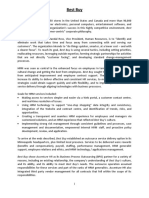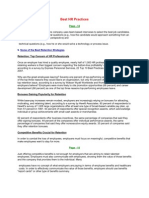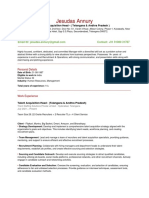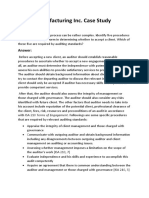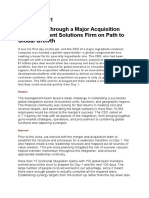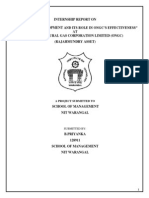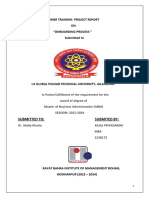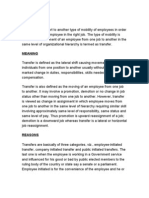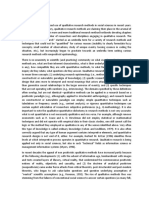Sipoc
Sipoc
Uploaded by
Soni Satriya D AnandaCopyright:
Available Formats
Sipoc
Sipoc
Uploaded by
Soni Satriya D AnandaOriginal Title
Copyright
Available Formats
Share this document
Did you find this document useful?
Is this content inappropriate?
Copyright:
Available Formats
Sipoc
Sipoc
Uploaded by
Soni Satriya D AnandaCopyright:
Available Formats
Defining a Process with SIPOC
What is SIPOC?
SIPOC is an abbreviation of:
Suppliers – Inputs – Process – Outputs – Customers
It provides a “template” for defining a process, before you begin to map, measure, or improve it.
Why use it?
Whenever you are planning to start some process management or improvement activity, it’s
important to get a high-level understanding of the scope of the process first. A SIPOC Process
Definition helps the Process Owner and those working on the process to agree the boundaries of
what they will be working on.
It provides a structured way to discuss the process and get consensus on what it involves before
rushing off and drawing process maps.
How to use it:
To create a SIPOC process definition:
1. Agree the name of the process. Use a Verb + Noun format (e.g. Recruit Staff).
2. Define the Outputs of the process. These are the tangible things that the process produces
(e.g. a report, or letter).
3. Define the Customers of the process. These are the people who receive the Outputs. Every
Output should have a Customer.
4. Define the Inputs to the process. These are the things that trigger the process. They will
often be tangible (e.g. a customer request)
5. Define the Suppliers to the process. These are the people who supply the inputs. Every
input should have a Supplier. In some “end-to-end” processes, the supplier and the
customer may be the same person.
6. Define the sub-processes that make up the process. These are the activities that are carried
out to convert the inputs into outputs. They will form the basis of a process map.
© 2008 Improvement Skills Consulting Ltd. Registered in England number 06427548
Registered Office: 204 Blind Lane, Flackwell Heath, High Wycombe HP10 9LE
T: +44 (0)7850 728506 E: info@improvement-skills.co.uk W: www.improvement-skills.co.uk
Defining a Process with SIPOC
SIPOC Example:
Process: Recruit Staff
Suppliers Inputs Process Outputs Customers
Line Manager Request to fill a 1. Specify needs New member of Line Manager
vacancy 2. Authorise staff
recruitment
3. Place adverts
4. Assess
applicants
5. Offer
appointment
6. Confirm start
Above is a simplified example of a SIPOC. In practice, you may need to include several other
suppliers (e.g. Candidates, Recruitment Agencies) and other customers (HR Dept., Candidates).
Adding more definition:
There are several elements that you can add to make a SIPOC process definition more useful…
Include a Process Purpose statement. Define why the process exists; e.g. the recruit Staff process
exists to provide the right people, with the right skills at the right time. The purpose should reflect a
benefit to the organisation, not simply be a re-statement of the name of the process.
Identify the Process Owner. Decide who is the single, named individual with responsibility for the
end-to end process. That person needs to be involved in any definition and improvement activities.
Define the start and end-points of the process. These will be the first and last activities on the
process map. Note that some processes may have multiple start and end points.
Define any boundaries, or scope limitations for the process. For example, does the process deal
with all types of customer, or just some (e.g. Retail vs. Business Customers)? Or, does the process
only deal with a particular type of transaction (e.g. high risk vs. low risk)? These boundaries can
help you decide whether you need more than one process map, or if everything can be included in
one map.
© 2008 Improvement Skills Consulting Ltd. Registered in England number 06427548
Registered Office: 204 Blind Lane, Flackwell Heath, High Wycombe HP10 9LE
T: +44 (0)7850 728506 E: info@improvement-skills.co.uk W: www.improvement-skills.co.uk
Defining a Process with SIPOC
Getting it right:
To be useful, your SIPOC process definition needs to follow the basic steps listed above. There are
some common errors that people make when defining a process. Here’s how to avoid them…
Good practice Common errors
Process names define how you Use Verb + Noun format: Names that use the “past
“do stuff”; no more, no less. e.g. “Recruit Staff” or “Prepare tense”:
Reports”. e.g. “Staff Recruited”, or
“Reports Produced”
Process names should not Use the Process Purpose Names that define what the
define performance Statement to define why the process is trying to achieve:
requirements or improvement process exists. That will help e.g. “Recruit Staff Quickly”, or
objectives. you to identify improvement “Improve Report Timeliness”.
objectives and performance These are improvement
measurements. objectives, not names of the
process.
Outputs should specify what Outputs are “things”. They Outputs that are actually
the process delivers, not what it may be right, or with errors. outcomes; e.g. “Satisfied
achieves. They may meet customer Customers” or “On-time
needs, or not. Reports”.
Inputs should specify what Inputs are “things” provided by Staff and other resources
triggers the process and what suppliers to the process. included as inputs. They don’t
gets “worked on” by the trigger the process and don’t
process. get worked on by it.
Policies and Rules included as
inputs. These guide the
process, but don’t get worked
on by it.
© 2008 Improvement Skills Consulting Ltd. Registered in England number 06427548
Registered Office: 204 Blind Lane, Flackwell Heath, High Wycombe HP10 9LE
T: +44 (0)7850 728506 E: info@improvement-skills.co.uk W: www.improvement-skills.co.uk
Defining a Process with SIPOC
SIPOC Summary
Sub-process Process
Policies steps Purpose
& Rules
Input Output
Process Name
(Verb + Noun)
Suppliers Customers
Process Owner
Staff & Resources
© 2008 Improvement Skills Consulting Ltd. Registered in England number 06427548
Registered Office: 204 Blind Lane, Flackwell Heath, High Wycombe HP10 9LE
T: +44 (0)7850 728506 E: info@improvement-skills.co.uk W: www.improvement-skills.co.uk
Defining a Process with SIPOC
SIPOC Process Definition Template:
Process:
Purpose:
Owner:
Suppliers Inputs Process Outputs Customers
Steps
Boundaries:
Start-point: End-point:
Includes: Excludes:
© 2008 Improvement Skills Consulting Ltd. Registered in England number 06427548
Registered Office: 204 Blind Lane, Flackwell Heath, High Wycombe HP10 9LE
T: +44 (0)7850 728506 E: info@improvement-skills.co.uk W: www.improvement-skills.co.uk
You might also like
- OJT Plan For HR (12 Weeks)Document3 pagesOJT Plan For HR (12 Weeks)JingWen LeeNo ratings yet
- Ashton Tate Limited ANSWERDocument4 pagesAshton Tate Limited ANSWERJoseph HallNo ratings yet
- Citect SCADA - Compile Error MessagesDocument13 pagesCitect SCADA - Compile Error Messagesconnect.rohit85No ratings yet
- Case - SHRM - Best BuyDocument2 pagesCase - SHRM - Best BuyAmy FitzpatrickNo ratings yet
- Functional Organiz Ational Chart (As of May 2020)Document1 pageFunctional Organiz Ational Chart (As of May 2020)James Patrick NarcissoNo ratings yet
- Manila Water 2010 Sustainability ReportDocument60 pagesManila Water 2010 Sustainability ReportArlina Liongson100% (1)
- Complex Analysis. Function TheoryDocument109 pagesComplex Analysis. Function TheoryHanzDucNguyen100% (3)
- Siemens Case StudyDocument1 pageSiemens Case Studyapi-344089351No ratings yet
- Best HR PracticesDocument2 pagesBest HR PracticesKavitha PaladugulaNo ratings yet
- Case Study 1Document2 pagesCase Study 1pzf3040867% (3)
- Group 7 Scope StatementDocument17 pagesGroup 7 Scope Statementapi-335995226100% (4)
- Julphar Annual ReportDocument61 pagesJulphar Annual ReportzeeshanshahbazNo ratings yet
- Highstone Electronics Case StudyDocument14 pagesHighstone Electronics Case StudyuberkoenNo ratings yet
- Exercise1-Group2-Hr Strategy For VietcombankDocument5 pagesExercise1-Group2-Hr Strategy For VietcombankNguyễn Vũ Đăng UyênNo ratings yet
- Presentation 2Document22 pagesPresentation 2Shuvo DattaNo ratings yet
- Khimji RamdasDocument24 pagesKhimji RamdasdipinmahajanNo ratings yet
- 10 Decision Areas of Operations Management: Google 'S Human Resource ManagementDocument2 pages10 Decision Areas of Operations Management: Google 'S Human Resource ManagementMian RehmanNo ratings yet
- Marketing EnvironmentDocument23 pagesMarketing EnvironmentSudu PuthaNo ratings yet
- Jesudas Annury - CV - TA Head - WebPTDocument6 pagesJesudas Annury - CV - TA Head - WebPTandeepthiNo ratings yet
- Chapter 8Document26 pagesChapter 8ahmadNo ratings yet
- OB 33 BS 16 Employee Stakeholders and Workplace IssuesDocument25 pagesOB 33 BS 16 Employee Stakeholders and Workplace IssuesberitahrNo ratings yet
- FDM On-Campus Module 1 TheFinancialLandscapeDocument12 pagesFDM On-Campus Module 1 TheFinancialLandscapeAllanNo ratings yet
- International Mergers and Acquisitions, International Joint Ventures, and AlliancesDocument33 pagesInternational Mergers and Acquisitions, International Joint Ventures, and AlliancesSteve HanNo ratings yet
- Chapter 7Document43 pagesChapter 7Yun LeeNo ratings yet
- A Winning Approach To Employee Success HBRAS QWDocument12 pagesA Winning Approach To Employee Success HBRAS QWcoolsar25No ratings yet
- Executive Onboarding PDFDocument2 pagesExecutive Onboarding PDFBrittany0% (1)
- IPM CCHRMproject 2Document36 pagesIPM CCHRMproject 2thiva198586% (7)
- Organizational ControlDocument2 pagesOrganizational ControlTony Davis100% (1)
- HR Case Studies Part IDocument9 pagesHR Case Studies Part Ihappyhero86No ratings yet
- Competency AssignmentDocument35 pagesCompetency AssignmentBharti100% (1)
- OBHR 202 - W05 Exercise Compensation Management CaseDocument6 pagesOBHR 202 - W05 Exercise Compensation Management CaseDinaHengNo ratings yet
- Unilever 1Document34 pagesUnilever 1Đặng HữuNo ratings yet
- Case Study 1Document4 pagesCase Study 1Bon-Jovi DuarteNo ratings yet
- Integrity Managment and Cultural Due DiligenceDocument46 pagesIntegrity Managment and Cultural Due Diligencestars_70000No ratings yet
- Ocean Manufacturing Inc. Case Study: Before Accepting A New Client, An Auditor Should Establish ReasonableDocument7 pagesOcean Manufacturing Inc. Case Study: Before Accepting A New Client, An Auditor Should Establish ReasonableAssignemntNo ratings yet
- HRM of Coca - ColaDocument10 pagesHRM of Coca - ColaJM MANOJKUMARNo ratings yet
- Chapter 1Document32 pagesChapter 1Trixie MatanguihanNo ratings yet
- Retention of Human CapitalDocument70 pagesRetention of Human CapitalHugo Zavala RodríguezNo ratings yet
- Infosys Case StudyDocument8 pagesInfosys Case StudyPratyaksh JainNo ratings yet
- Functions of Human Resource Department of State Bank of PakistanDocument40 pagesFunctions of Human Resource Department of State Bank of PakistanInfinityIcon100% (8)
- Assistant Manager - HRDDocument2 pagesAssistant Manager - HRDNilamsari Gobano PutriNo ratings yet
- 2013 Research Paper On Rewards and RecognitionDocument30 pages2013 Research Paper On Rewards and RecognitionSatyajeet MukherjeeNo ratings yet
- (DMBA112) Human Resource ManagementDocument9 pages(DMBA112) Human Resource Managementrhisavmukherjee21No ratings yet
- Compensation ManagementDocument13 pagesCompensation Managementfarhatafaja0% (1)
- AC119 Cashflow StatementDocument82 pagesAC119 Cashflow StatementTINASHENo ratings yet
- Recruitment and Selection ManagementDocument21 pagesRecruitment and Selection ManagementaswinthariNo ratings yet
- Case StudyDocument42 pagesCase StudyHarshadaNo ratings yet
- Intern ReportDocument65 pagesIntern ReportPriyanka BujugundlaNo ratings yet
- Human Resource Management: Acme Widget CompanyDocument16 pagesHuman Resource Management: Acme Widget CompanySREENo ratings yet
- QuestionsDocument32 pagesQuestionsKhushboo KhannaNo ratings yet
- The Labour Market ContextDocument30 pagesThe Labour Market Contextmansit26No ratings yet
- Human Resource PlanningDocument15 pagesHuman Resource PlanningKurnool LionsNo ratings yet
- Alectek Shoes Case StudyDocument2 pagesAlectek Shoes Case StudySnigdha0% (1)
- Onboarding FinalDocument53 pagesOnboarding Finalkajal.priyadarshiniNo ratings yet
- TransferDocument6 pagesTransferDeepa AlwaniNo ratings yet
- Role of Expectations in Organizational EntryDocument6 pagesRole of Expectations in Organizational EntryMd. Erfan AhmedNo ratings yet
- Allentown Materials CorporationDocument13 pagesAllentown Materials CorporationVenkataramanan VaidyanathanNo ratings yet
- Human Resource Planning OutlineDocument4 pagesHuman Resource Planning OutlineWaqas SheikhNo ratings yet
- Recruitment Process Outsourcing A Complete Guide - 2020 EditionFrom EverandRecruitment Process Outsourcing A Complete Guide - 2020 EditionNo ratings yet
- Value Chain Management Capability A Complete Guide - 2020 EditionFrom EverandValue Chain Management Capability A Complete Guide - 2020 EditionNo ratings yet
- Yale University PressDocument15 pagesYale University Presssamon sumulongNo ratings yet
- Written LawsDocument2 pagesWritten LawsShechem NinoNo ratings yet
- Guia de Estudio: Ingles IvDocument6 pagesGuia de Estudio: Ingles IvBerenice FloresNo ratings yet
- The 7 Components of CommunicationDocument3 pagesThe 7 Components of CommunicationSheeva AbenidoNo ratings yet
- Narrative Text FixDocument8 pagesNarrative Text FixRikka TakanashiNo ratings yet
- 03 - Early Russia Guided NotesDocument2 pages03 - Early Russia Guided Notesdoug.flitcroftNo ratings yet
- DipsTrans BrochureDocument9 pagesDipsTrans BrochureShantsan LeighNo ratings yet
- Aqa English Language Gcse Coursework Mark SchemeDocument8 pagesAqa English Language Gcse Coursework Mark Schemef5d7ejd0100% (1)
- ENGLISH 5 Q2 W3 Informational Text - Types by Sir Rei MarasiganDocument21 pagesENGLISH 5 Q2 W3 Informational Text - Types by Sir Rei MarasiganERMINIO DE LA CRUZ100% (3)
- English 7Document4 pagesEnglish 7Yujee LeeNo ratings yet
- MULTIPLE ROOTS REVERSE CUTHILL-McKEE MET PDFDocument10 pagesMULTIPLE ROOTS REVERSE CUTHILL-McKEE MET PDFvttrlcNo ratings yet
- Laravel DeveloperDocument1 pageLaravel DeveloperMishal AmjadNo ratings yet
- Types of ComputerDocument1 pageTypes of Computerthenameisyash118No ratings yet
- Download Full Vatican II The Essential Texts Tanner Norman; PDF All ChaptersDocument34 pagesDownload Full Vatican II The Essential Texts Tanner Norman; PDF All Chapterstrushospier100% (3)
- INTRODUCTIONDocument4 pagesINTRODUCTIONAyu Ansyari TrianaNo ratings yet
- EC303Document19 pagesEC303api-3853441No ratings yet
- Telephony Solutions Installing and Customizing AsteriskDocument833 pagesTelephony Solutions Installing and Customizing AsteriskDiegoKodnerNo ratings yet
- Mit Opencourseware: 6.096 Introduction To C++Document7 pagesMit Opencourseware: 6.096 Introduction To C++haniballkinga2778No ratings yet
- ISSMA Group I List 2016Document30 pagesISSMA Group I List 2016MusicDramaMamaNo ratings yet
- Raghavendra GuvvalaDocument2 pagesRaghavendra GuvvalaRaghu ReddyNo ratings yet
- AWS Administrator Resume SampleDocument4 pagesAWS Administrator Resume SampleHoviNo ratings yet
- Asking and Giving AdvicesDocument3 pagesAsking and Giving AdvicesummalaNo ratings yet
- Phython 1Document20 pagesPhython 1Divyansh Rana100% (2)
- English FAL P2 Nov 2014Document26 pagesEnglish FAL P2 Nov 2014bandilengwenyama7No ratings yet
- CSCI 201 - Assignment 3Document2 pagesCSCI 201 - Assignment 3Victor DavisNo ratings yet
- Worksheet in Datawarehousing Case Study - Building ETL ProcessesDocument37 pagesWorksheet in Datawarehousing Case Study - Building ETL ProcessesgeoinsysNo ratings yet
- UntitledDocument6 pagesUntitledAnonymous AMmNGgPNo ratings yet



